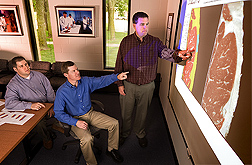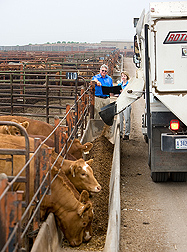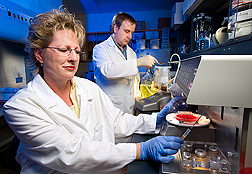Evaluating an Ethanol Byproduct
as a Potential Cattle Feed Ingredient
There may be no such thing as a free lunch, but a cheap meal is easy to come by—especially if you use the right ingredients.
With ethanol plants popping up across the nation, many cattle producers are weighing the effects of substituting a common ethanol byproduct for more costly traditional feed ingredients such as corn, soybean meal, urea, and mineral supplements.
The byproduct, called “wet distiller’s grains with solubles,” or WDGS, has potentially significant economic benefits. WDGS typically costs about 10 percent less than corn when used as livestock feed.
ARS scientists at the U.S. Meat Animal Research Center (USMARC) in Clay Center, Nebraska, are investigating the effects of feeding WDGS to cattle. The scientists carried out a comprehensive study on the influence of diets including WDGS in four areas: feedlot performance, energy utilization efficiency, postharvest meat characteristics, and cattle manure emissions. For these studies the cattle were fed diets containing 0, 20, 40, or 60 percent WDGS.
Research results show that WDGS, in moderation, may offer an inexpensive alternative to traditional feed ingredients.
Cattle Performance and Meat Quality
Some of the USMARC research investigated the impact of WDGS diets on cattle performance and meat quality. In one study, nutritionist Calvin Ferrell and food technologist Steven Shackelford monitored growth rate, feed intake, and feed efficiency for cattle in the “finishing phase,” that is, the roughly 120 to 140 days leading up to slaughter.
They found that for steers fed diets of 20 or 40 percent WDGS, performance in these areas was equal to or better than that of the control group. But cattle fed a diet of 60 percent WDGS had lower feed intake and average daily gain. Nonetheless, Ferrell is not willing to rule out the 60-percent diets.
“They could be a viable option, depending on relative costs of other feed ingredients,” he says.
Another study, led by animal scientist Mindy Spiehs, took a closer look at feed efficiency by examining how much heat the animals produced while digesting their food. Among the different feeds, Spiehs and her colleagues observed no significant difference in heat production. But they did see lower energy utilization efficiency—a factor that could reduce feedlot performance—in the cattle fed WDGS diets. The decreased efficiency was particularly noticeable in the 60-percent diets.
|
|
The changes in cattle performance were similar to those observed in meat quality in the portion of the study conducted by Shackelford, research leader Tommy Wheeler, and food technologist Andy King. The heaviest, fattest carcasses were from cattle fed a diet of 20 percent WDGS. Cattle on the 40-percent diet also performed better than the control group, but the 60-percent group had the lowest performance of all. They were lighter, leaner, less marbled, and had lower yield grades than cattle in the other three groups.
Like Ferrell, Shackelford is not entirely convinced that the disadvantages of this poor performance would outweigh the economic savings of the low-cost feed. This study only addressed the effects of diet during the finishing phase, he notes, not the approximately 6-month growing phase that preceded it.
“There may be merit to pursuing research where cattle are fed high WDGS levels in the growing phase and lower levels of WDGS during the finishing phase,” Shackelford says.
Environmental Impact
These studies also investigated the environmental impact of adding WDGS to cattle feed. Cattle diets that include WDGS often contain more crude protein and minerals than the animals need, which could result in greater nitrogen emissions, phosphorus runoff, and odor problems.
A study led by microbiologist Vince Varel confirmed that WDGS diets can increase the amount of odorants in manure slurries. This is one area in which the control group performed better than those fed diets with WDGS.
“As the concentration of WDGS increased in the diet, greater concentrations of nitrogen, phosphorus, and sulfur appeared in the manure,” Varel says. This raised the potential for phosphorus runoff and increased the presence of malodorous compounds.
Another part of this study, conducted by microbiologists Jim Wells and Elaine Berry, examined how WDGS diets affected persistence of generic E. coli in cattle feces. Early results showed an inverse relationship between the amount of WDGS in a diet and the amount of L-lactate in cattle manure slurries. Slurries with more L-lactate had lower pH, resulting in less microbial fermentation, methane, and E. coli. This suggests that feeding WDGS to cattle can lead to manure with less L-lactate and thus a greater potential for odor emissions and more persistent E. coli.
Further studies are needed to determine whether WDGS feeds raise the likelihood of pathogenic E. coli persisting in cattle manure.
These potential concerns will require more research. But from a holistic standpoint, the USMARC studies indicate that a cattle diet of 20 percent to 40 percent WDGS may offer the most economic benefits with the fewest disadvantages. Future studies could examine the feed’s environmental and food safety impact and determine whether and how diets of 60 percent WDGS might be a savvy management choice.
That’s good news for the cattle industry. WDGS is a high-quality, low-cost feed ingredient, and producers are likely to use as much as they can. Research like this is essential to helping them decide how to capitalize on its benefits without compromising growth performance, meat quality, or the environment.—By Laura McGinnis, formerly with ARS.
This research is part of Food Animal Production (#101), Food Safety (#108), and Manure and Byproduct Utilization (#206), three ARS national programs described on the World Wide Web at www.nps.ars.usda.gov.
To reach scientists mentioned in this article, contact Robert Sowers, USDA-ARS Information Staff, 5601 Sunnyside Ave., Beltsville, MD 20705-5129; phone (301) 504-1651, fax (301) 504-1486.
"Evaluating an Ethanol Byproduct as a Potential Cattle Feed Ingredient" was published in the September 2009 issue of Agricultural Research magazine.










